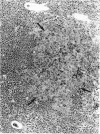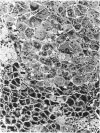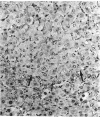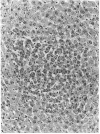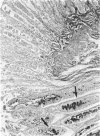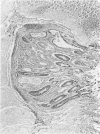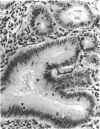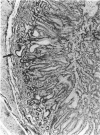Abstract
Aroclor 1254 was fed to groups of 24 male and 24 female F344 rats, from 7 weeks of age, at dietary concentrations of 25, 50 and 100 ppm for up to 105 weeks. There was a dose- related depression of body weight gain for both sexes and decrease in survival for male rats. Histologically, an increased incidence of gastric intestinal metaplasia and adenocarcinoma was found in both sexes. Hepatocellular adenomas, carcinomas, and eosinophilic and vacuolated hepatocellular foci were usually found in dosed rats only. The number of these foci per unit area of liver was significantly increased in dosed rats, although eosinophilic foci were only found in rats exposed to Aroclor 1254. Basophilic hepatocellular foci were found in similar numbers per square centimeter of liver in controls and treated rats. This finding suggested that eosinophilic hepatocellular foci and tumors arose de novo rather than from the naturally occurring basophilic foci. The appearance of unique, potentially preneoplastic lesions and tumors in the liver and stomach in dosed rats which do not usually occur spontaneously in control rats would support the hypothesis that Aroclor 1254 induced or initiated these unique lesions de novo rather than promoted the growth of any naturally occurring lesions. Nonneoplastic hepatic lesions included degenerative hepatocellular changes and aggregates of macrophages with crystalline cytoplasmic structures and pigment granules.
Full text
PDF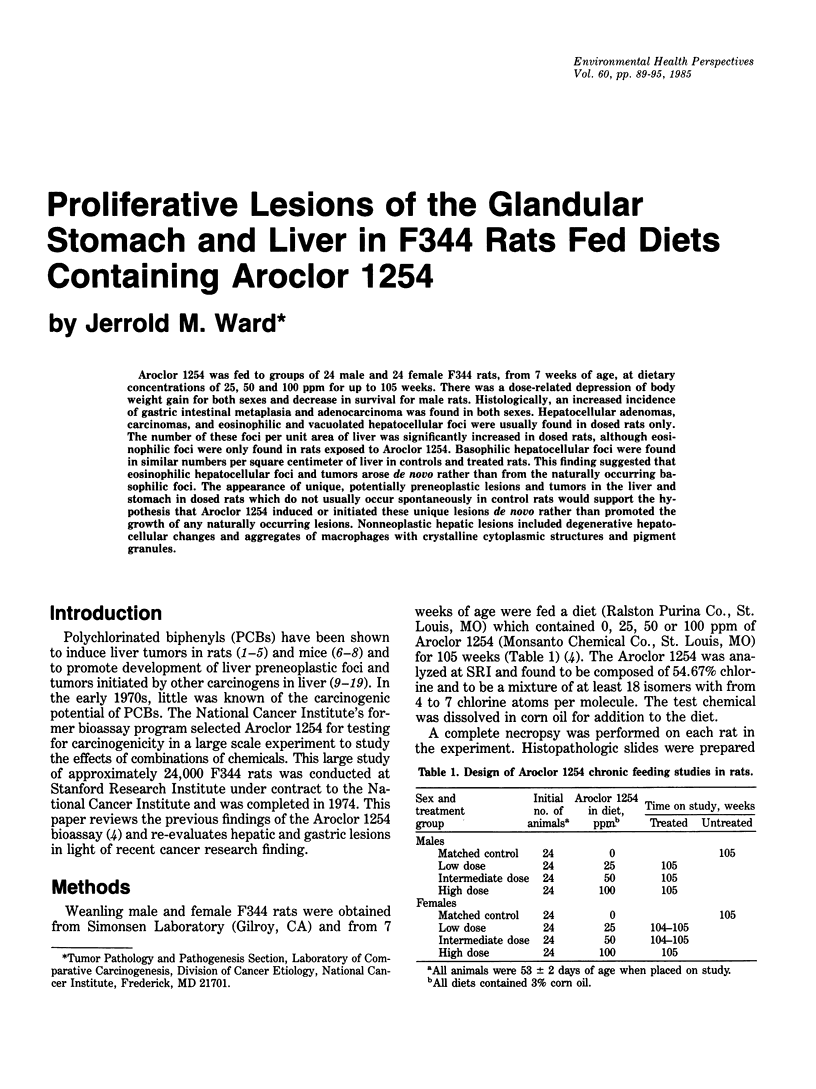

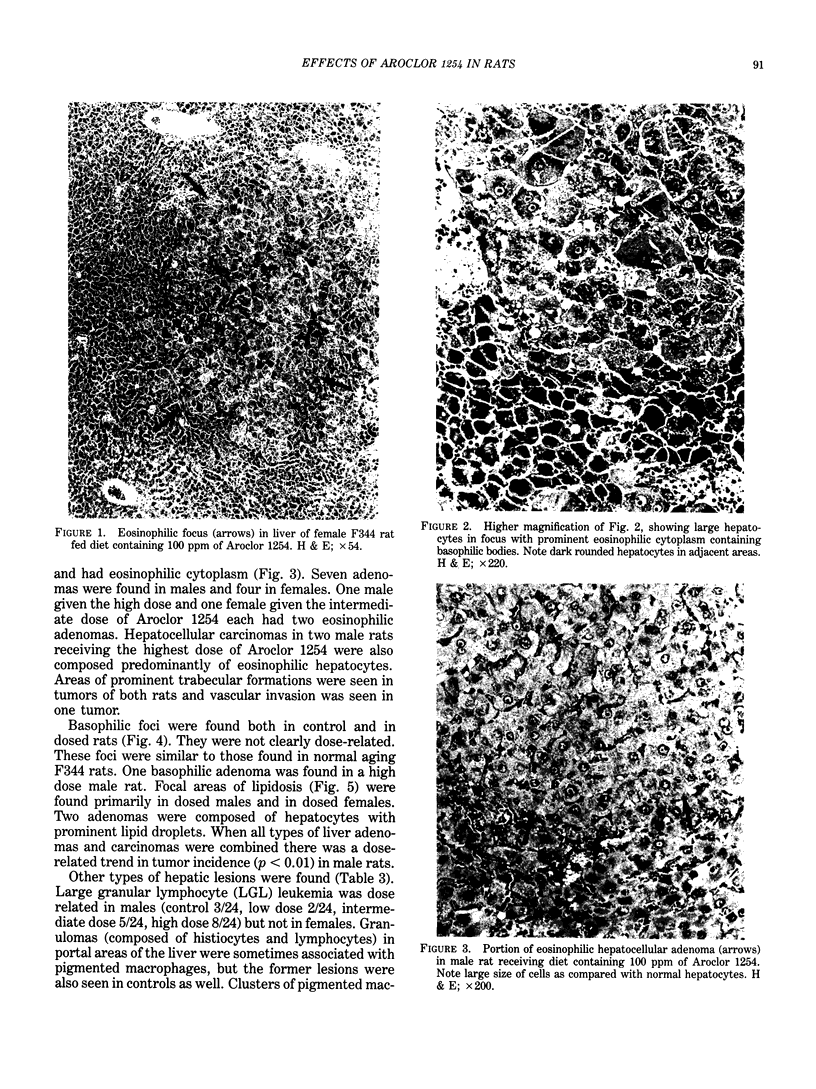

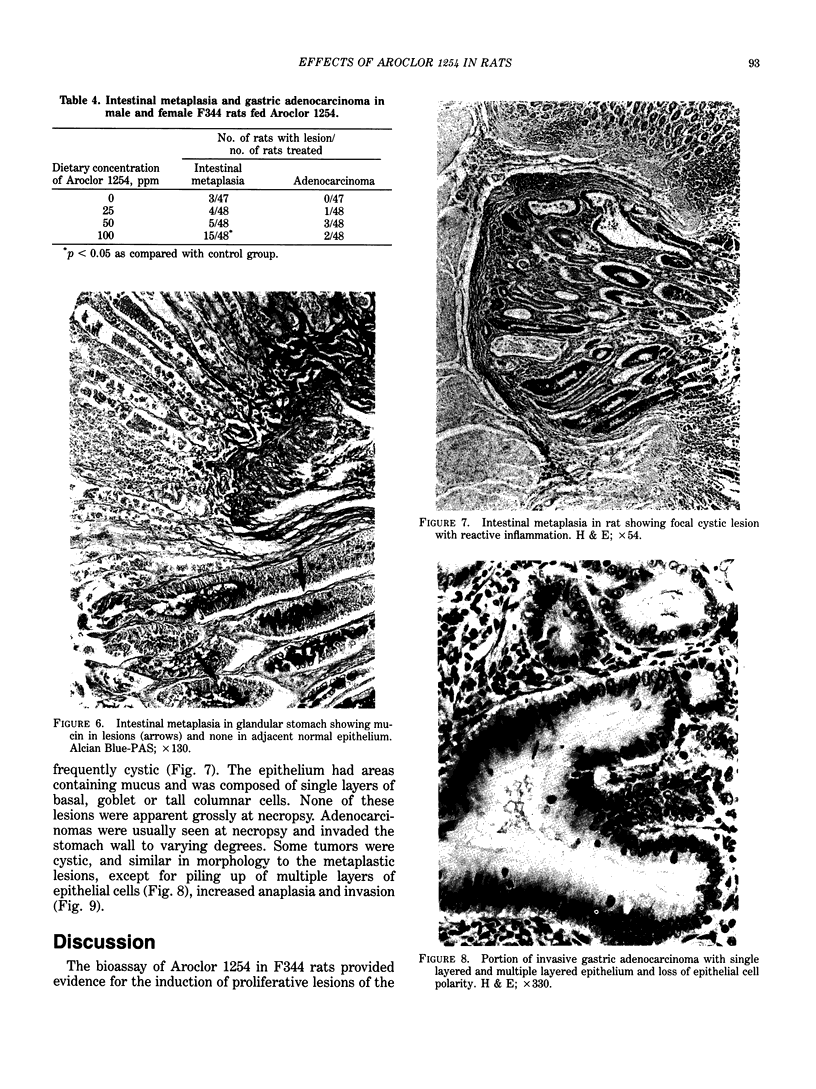
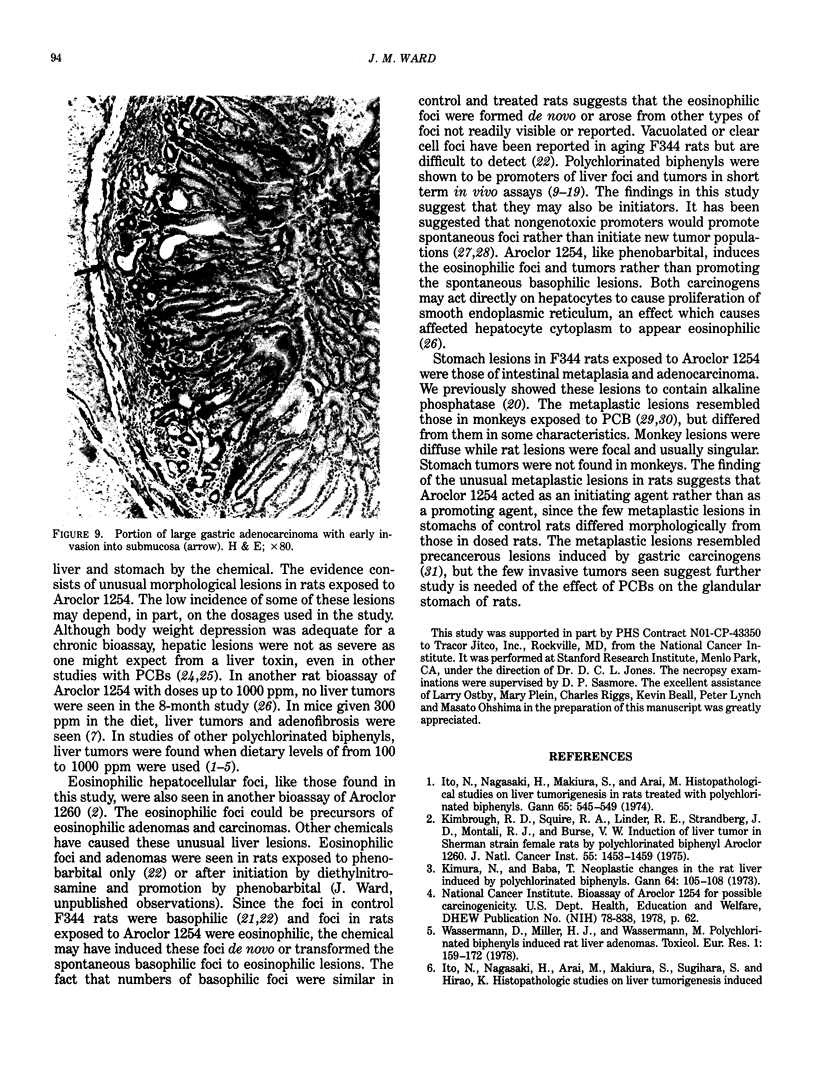
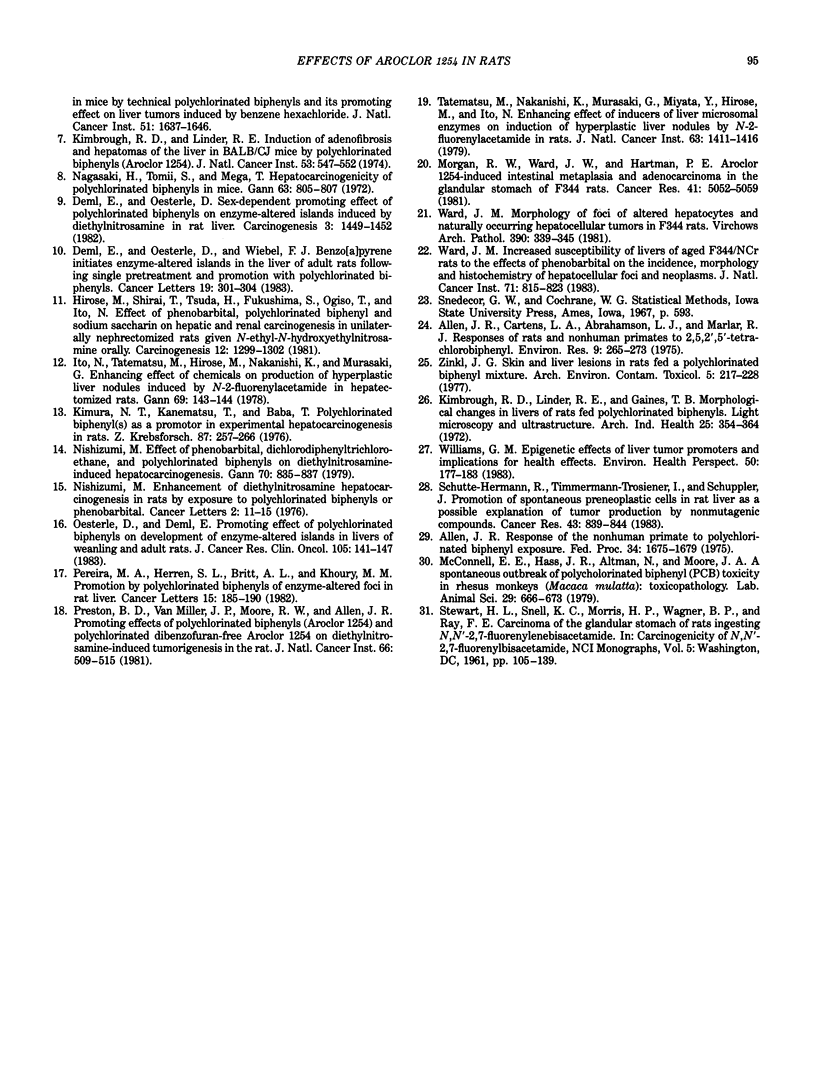
Images in this article
Selected References
These references are in PubMed. This may not be the complete list of references from this article.
- Allen J. R., Cartens L. A., Abrahamson L. J., Marlar R. J. Responses of rats and nonhuman primates to 2,5,2',5'-tetrachlorobiphenyl. Environ Res. 1975 Jun;9(3):265–273. doi: 10.1016/0013-9351(75)90006-7. [DOI] [PubMed] [Google Scholar]
- Allen J. R. Response of the nonhuman primate to polychlorinated biphenyl exposure. Fed Proc. 1975 Jul;34(8):1675–1679. [PubMed] [Google Scholar]
- Deml E., Oesterle D. Sex-dependent promoting effect of polychlorinated biphenyls on enzyme-altered islands induced by diethylnitrosamine in rat liver. Carcinogenesis. 1982;3(12):1449–1452. doi: 10.1093/carcin/3.12.1449. [DOI] [PubMed] [Google Scholar]
- Deml E., Oesterle D., Wiebel F. J. Benzo[a]pyrene initiates enzyme-altered islands in the liver of adult rats following single pretreatment and promotion with polychlorinated biphenyls. Cancer Lett. 1983 Jul;19(3):301–304. doi: 10.1016/0304-3835(83)90098-8. [DOI] [PubMed] [Google Scholar]
- Ito N., Nagasaki H., Makiura S., Arai M. Histopathological studies on liver tumorigenesis in rats treated with polychlorinated biphenyls. Gan. 1974 Dec;65(6):545–549. [PubMed] [Google Scholar]
- Ito N., Tatematsu M., Hirose M., Nakanishi K., Murasaki G. Enhancing effect of chemicals on production of hyperplastic liver nodules induced by n-2-fluorenylacetamide in hepatectomized rats. Gan. 1978 Feb;69(1):143–144. [PubMed] [Google Scholar]
- Kimbrough R. D., Linder R. E., Gaines T. B. Morphological changes in livers of rats fed polychlorinated biphenyls: light microscopy and ultrastructure. Arch Environ Health. 1972 Nov;25(5):354–364. doi: 10.1080/00039896.1972.10666186. [DOI] [PubMed] [Google Scholar]
- Kimbrough R. D., Linder R. E. Induction of adenofibrosis and hepatomas of the liver in BALB-cJ mice by polychlorinated biphenyls (Aroclor 1254). J Natl Cancer Inst. 1974 Aug;53(2):547–552. doi: 10.1093/jnci/53.2.547. [DOI] [PubMed] [Google Scholar]
- Kimbrough R. D., Squire R. A., Linder R. E., Strandberg J. D., Montalli R. J., Burse V. W. Induction of liver tumor in Sherman strain female rats by polychlorinated biphenyl aroclor 1260. J Natl Cancer Inst. 1975 Dec;55(6):1453–1459. doi: 10.1093/jnci/55.6.1453. [DOI] [PubMed] [Google Scholar]
- Kimura N. T., Baba T. Neoplastic changes in the rat liver induced by polychlorinated biphenyl. Gan. 1973 Feb;64(1):105–108. [PubMed] [Google Scholar]
- Kimura N. T., Kanematsu T., Baba T. Polychlorinated biphenyl(s) as a promotor in experimental hepatocarcinogenesis in rats. Z Krebsforsch Klin Onkol Cancer Res Clin Oncol. 1976 Dec 9;87(3):257–266. doi: 10.1007/BF00506498. [DOI] [PubMed] [Google Scholar]
- McConnell E. E., Hass J. R., Altman N., Moore J. A. A spontaneous outbreak of polycholorinated biphenyl (PCB) toxicity in rhesus monkeys (Macaca mulatta): toxicopathology. Lab Anim Sci. 1979 Oct;29(5):666–673. [PubMed] [Google Scholar]
- Morgan R. W., Ward J. M., Hartman P. E. Aroclor 1254-induced intestinal metaplasia and adenocarcinoma in the glandular stomach of F344 rats. Cancer Res. 1981 Dec;41(12 Pt 1):5052–5059. [PubMed] [Google Scholar]
- Nagasaki H., Tomii S., Mega T., Marugami M., Ito N. Hepatocarcinogenicity of polychlorinated biphenyls in mice. Gan. 1972 Dec;63(6):805–805. [PubMed] [Google Scholar]
- Nishizumi M. Effect of phenobarbital, dichlorodiphenyltrichloroethane, and polychlorinated biphenyls on diethylnitrosamine-induced hepatocarcinogenesis. Gan. 1979 Dec;70(6):835–837. [PubMed] [Google Scholar]
- Nishizumi M. Enhancement of diethylnitrosamine hepatocarcinogenesis in rats by exposure to polychlorinated biphenyls or phenobarbital. Cancer Lett. 1976 Sep;2(1):11–15. doi: 10.1016/s0304-3835(76)80004-3. [DOI] [PubMed] [Google Scholar]
- Oesterle D., Deml E. Promoting effect of polychlorinated biphenyls on development of enzyme-altered islands in livers of weanling and adult rats. J Cancer Res Clin Oncol. 1983;105(2):141–147. doi: 10.1007/BF00406924. [DOI] [PubMed] [Google Scholar]
- Pereira M. A., Herren S. L., Britt A. L., Khoury M. M. Promotion by polychlorinated biphenyls of enzyme-altered foci in rat liver. Cancer Lett. 1982 Feb;15(2):185–190. doi: 10.1016/0304-3835(82)90050-7. [DOI] [PubMed] [Google Scholar]
- Preston B. D., Van Miller J. P., Moore R. W., Allen J. R. Promoting effects of polychlorinated biphenyls (Aroclor 1254) and polychlorinated dibenzofuran-free Aroclor 1254 on diethylnitrosamine-induced tumorigenesis in the rat. J Natl Cancer Inst. 1981 Mar;66(3):509–515. [PubMed] [Google Scholar]
- Schulte-Hermann R., Timmermann-Trosiener I., Schuppler J. Promotion of spontaneous preneoplastic cells in rat liver as a possible explanation of tumor production by nonmutagenic compounds. Cancer Res. 1983 Feb;43(2):839–844. [PubMed] [Google Scholar]
- Tatematsu M., Nakanishi K., Murasaki G., Miyata Y., Hirose M., Ito N. Enhancing effect of inducers of liver microsomal enzymes on induction of hyperplastic liver nodules by N-2-fluorenylacetamide in rats. J Natl Cancer Inst. 1979 Dec;63(6):1411–1416. [PubMed] [Google Scholar]
- Ward J. M. Increased susceptibility of livers of aged F344/NCr rats to the effects of phenobarbital on the incidence, morphology, and histochemistry of hepatocellular foci and neoplasms. J Natl Cancer Inst. 1983 Oct;71(4):815–823. [PubMed] [Google Scholar]
- Ward J. M. Morphology of foci of altered hepatocytes and naturally-occurring hepatocellular tumors in F344 rats. Virchows Arch A Pathol Anat Histol. 1981;390(3):339–345. doi: 10.1007/BF00496563. [DOI] [PubMed] [Google Scholar]
- Wassermann D., Miller H. J., Wassermann M. Polychlorinated biphenyls induced rat liver adenomas. Toxicol Eur Res. 1978 May;1(3):159–172. [PubMed] [Google Scholar]
- Williams G. M. Epigenetic effects of liver tumor promoters and implications for health effects. Environ Health Perspect. 1983 Apr;50:177–183. doi: 10.1289/ehp.8350177. [DOI] [PMC free article] [PubMed] [Google Scholar]
- Zinkl J. G. Skin and liver lesions in rats fed a polychlorinated biphenyl mixture. Arch Environ Contam Toxicol. 1977;5(2):217–228. doi: 10.1007/BF02220905. [DOI] [PubMed] [Google Scholar]



